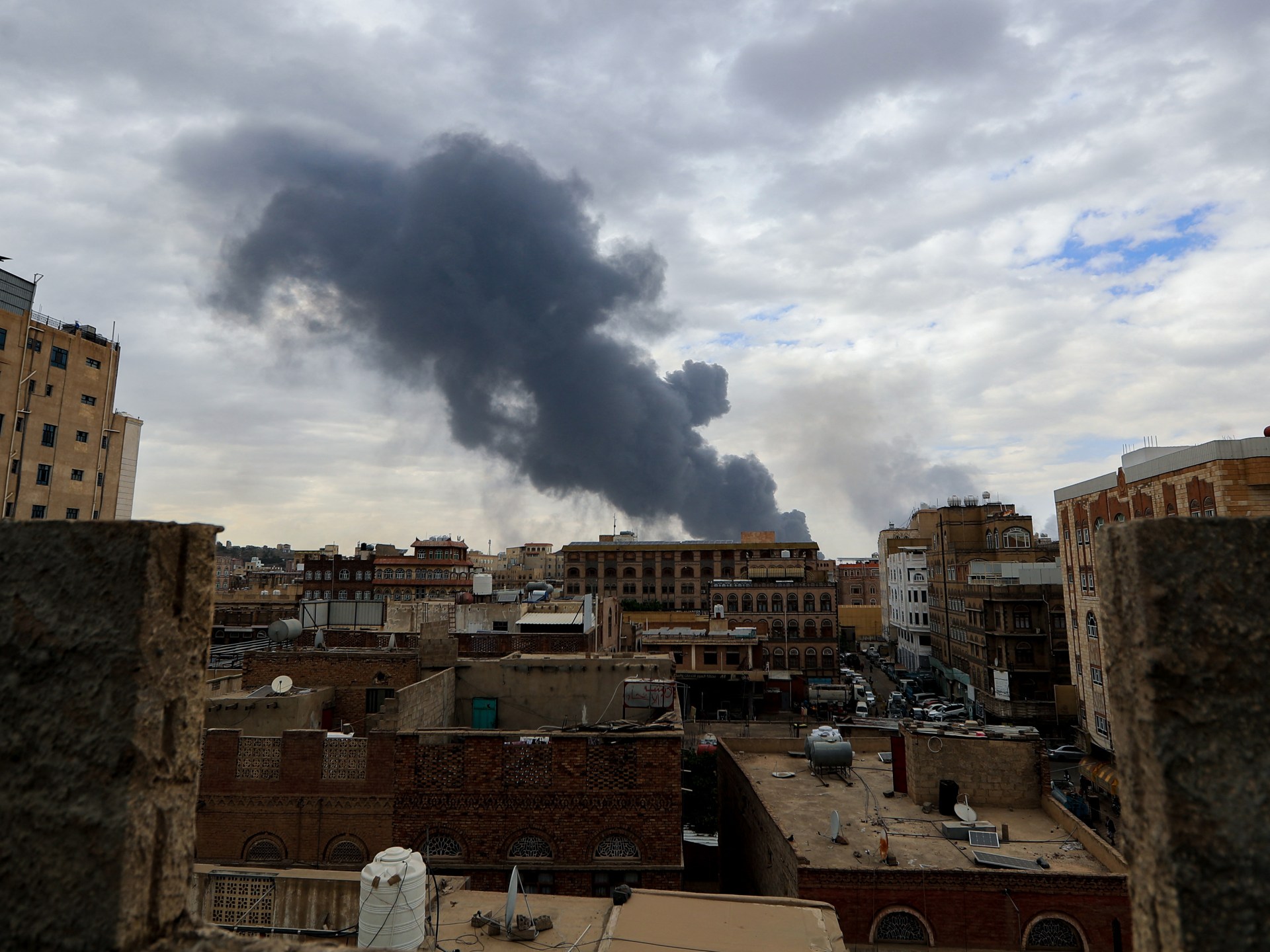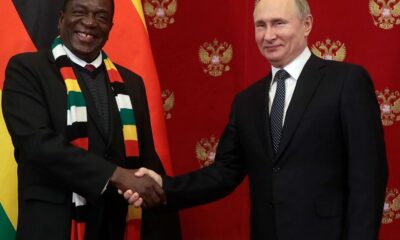Middle East
Israel attacks Yemen’s Hodeidah, striking port areas | News

Israel has previously bombed Hodeidah and Sanaa International Airport; Houthi missile targeted Ben Gurion Airport in Tel Aviv.
Israel has launched air attacks on Yemen’s Hodeidah governorate, according to the Houthi Interior Ministry.
The attack late on Sunday came after the Israeli army said it had warned those present at three Houthi-controlled ports in the area to evacuate.
It was the latest salvo in exchanges between Israel and the Houthis.
Israel bombed the Hodeidah port after a Houthi attack near Ben Gurion Airport in Tel Aviv earlier this month.
Israeli strikes have also targeted parts of the Yemeni capital Sanaa and the main international airport there.
The Houthis have been firing missiles at Israel and on Israeli targets in the Red Sea in solidarity with Palestinians under fire since the war on Gaza began 19 months ago. Israeli attacks on Gaza have killed more than 52,000 people, including 57 who starved to death due to the total Israeli siege since March 2, according to Palestinian officials.
A ceasefire deal between Yemen’s Houthis and the United States does not include any operations against Israel, the group’s chief negotiator announced earlier this week. The Houthis stopped firing on Israel during the Gaza ceasefire earlier this year, but resumed when Israel imposed its punishing blockade and then resumed the war soon after.
The US military had been launching daily air strikes across Yemen for nearly two months, destroying infrastructure and killing dozens of people, including children and civilians.
Middle East
Trump visits Saudi Arabia, Qatar, UAE: What to know | Donald Trump News

United States President Donald Trump will undertake a three-day tour of the Gulf for his first state visit since retaking office in January.
The trip begins in Saudi Arabia, followed by Qatar and the United Arab Emirates.
It marks Trump’s second foreign visit as president after he attended Pope Francis’s funeral in Rome in April.
Here is what to know about the trip and what is on the agenda:
When and where is Trump visiting?
Trump will fly out of the US on Monday and start his trip in the Saudi capital, Riyadh, on Tuesday.
He is expected to attend a Gulf summit in the city on Wednesday, visit Qatar later that day and conclude his visit in the UAE on Thursday.
Saudi Arabia was the first country Trump visited during his first term as well, breaking the tradition of US presidents starting with the United Kingdom, Canada or Mexico.

What is on Trump’s agenda?
His objectives are securing major economic deals and making diplomatic progress on issues that impact the region, including a Gaza ceasefire and stalled Saudi-Israel normalisation talks.
The focus on economic deals comes as the US recorded a drop in its economic output in the first quarter, its first in three years.
On Wednesday, Trump said he will also decide during his trip how the US refers to the “Persian Gulf”.
US media reported that he may decide to refer to the body of water as the Arabian Gulf or the Gulf of Arabia.
Saudi Arabia: Normalisation, business deals and weapons
Trump’s Middle East envoy Steve Witkoff said the president wants to expand the Abraham Accords, under which the UAE and Bahrain recognised Israel during Trump’s first term, to include Saudi Arabia.
Talks were reportedly under way on Saudi Arabia joining the accords, but after Israel began its war on Gaza in October 2023, Saudi Crown Prince Mohammed bin Salman (MBS) paused those discussions.
Saudi officials have said they won’t move forward unless there is real progress towards a two-state solution for Palestine, leading to speculation that Trump may propose a US-backed framework to end the war and revive normalisation efforts during this visit.
In a shift from past US policy, the Trump administration has uncoupled discussions on a Saudi nuclear agreement and normalisation with Israel, which US President Joe Biden’s administration had held as a condition for nuclear cooperation.
Riyadh wants US help building a civilian nuclear programme, which Israel has raised concerns about and had wanted it tied to normalisation.
Trump’s main focus will be economic partnerships as he meets with MBS and attends a Saudi-US investment forum. He wants to secure a $1 trillion Saudi investment in US industries, expanding on a $600bn pledge made by the crown prince earlier this year.
Saudi Arabia is also expected to announce more than $100bn in US arms purchases, including missiles, radar systems and transport aircraft.
Other key issues include reviving a scaled-down US-Saudi defence pact.

UAE: Investment in the US and cooperation on tech goals
In the UAE, Trump is to meet with President Mohammed bin Zayed Al Nahyan to discuss investment opportunities in sectors such as artificial intelligence, semiconductors, energy and manufacturing.
In March, the UAE announced a $1.4 trillion investment plan for those sectors in the US over the next decade.
Meanwhile, Trump is expected to lift Biden-era export restrictions on advanced technology as the UAE seeks US microchips and artificial intelligence technology to support its goal of becoming a global AI leader by 2031.
Qatar: Military cooperation, regional security and Syria
In Qatar, where the largest US military base in the Middle East is located, Trump’s agenda includes meetings with the emir, Sheikh Tamim bin Hamad Al Thani, to discuss military cooperation and regional security.
Doha, which has close ties with Syria’s new president, Ahmed al-Sharaa, may also seek Trump’s support in easing sanctions on Syria.
As a key partner in regional mediation, Qatar is also expected to discuss Gaza ceasefire efforts with Trump.

Why is Israel not on the itinerary?
Trump’s decision to skip Israel during this tour comes amid heightened tensions in Gaza, where Israel’s military has intensified its operations after breaking a ceasefire on March 18.
“Nothing good can come out of a visit to Israel at the moment,” a US official told the Axios news website.
Since it broke the ceasefire, Israel has continued extensive air strikes on Gaza while voicing concerns over what it sees as a decline in US support.
Recent reports from US and Israeli media also suggest growing tensions between Trump and Israeli Prime Minister Benjamin Netanyahu as the Trump administration signals it may act independently on Middle East policy without waiting for the Israeli leader.
Israeli political commentator Ori Goldberg told Al Jazeera: “At the moment, Israel is at odds with [Trump’s] overall goal, promising continuous fire.
“I think the mistrust between Trump and Netanyahu has been quite extensive for some time.”
How are countries responding to this visit?
In the lead-up to Trump’s visit, Saudi Arabia, Qatar and the UAE pledged significant investments in the US, signalling an interest in deepening economic ties.
However, Trump’s trip also follows resistance in the region over his proposal for the US to redevelop Gaza and relocate its residents to other Arab countries.
In a meeting of Arab leaders in Riyadh in February, officials from countries including Egypt, Qatar, the UAE and Kuwait rejected Trump’s plan, emphasising the need for Palestinian self-determination and regional stability.
Middle East
Famine stalking across Gaza, 500,000 face starvation: Analysis | Israel-Palestine conflict News

All 2.1 million people in the Gaza Strip at critical risk if Israeli blockade persists, says report.
Israel’s blockade threatens the entire population of the Gaza Strip with famine and faces 500,000 with starvation, a global hunger monitor has warned.
A report by the Integrated Food Security Phase Classification (IPC) initiative, released on Monday, said the Gaza Strip “is still confronted with a critical risk of famine” after over a year and a half of devastating war, with the vast majority of its approximately 2.1 million people at severe risk.
Some 70 days after the Israeli military halted the entry of food, water, medicine and all other life-saving supplies into Gaza, the report said “goods indispensable for people’s survival are either depleted or expected to run out in the coming weeks”.
“The entire population is facing high levels of acute food insecurity, with half a million people (one in five) facing starvation,” it said. Approximately 93 percent of Gaza’s population is experiencing acute food shortages, it added.
Starvation looms for one in five in Gaza
Conditions have significantly worsened since the previous IPC report, released in October, with a higher percentage of the population facing more severe levels of food insecurity.
The entire population is expected to face “crisis” or worse levels of acute food insecurity if the Israeli siege persists. One in five is thought likely to face starvation between May and September.
Authorities in the bombarded territory said last week that at least 57 people had starved to death as a result of Israel’s blockade.
Widespread acute malnutrition is anticipated, the analysis adds, especially in mostly destroyed northern Gaza and in Rafah in the southernmost part of the Strip.
🔴 #GazaStrip
The Gaza Strip—approximately 2.1 million people—continues facing a critical risk of Famine following 19 months of conflict, mass displacement, and humanitarian aid blockade.
📉 Extreme hunger is deepening every day!
⚠️ 1 in every 5 people faces starvation between… pic.twitter.com/z7uN9ifnpC
— The Integrated Food Security Phase Classification (@theIPCinfo) May 12, 2025
A continued blockade “would likely result in further mass displacement within and across governorates”, the report said.
“The vast majority of people in the Gaza Strip would not have access to food, water, shelter, and medicine. This would exacerbate civil unrest and competition over remaining scarce resources, further eroding whatever limited community coping and support mechanisms remain.”
Calls for ‘urgent action’ as food prices skyrocket 3,000%
Food prices in Gaza are soaring excessively.
The IPC report points to a 3,000 percent increase in the price of wheat flour since February in Deir el-Balah in central Gaza and Khan Younis in the south.
The analysis calls for “urgent action” to end the hostilities, allow unhindered humanitarian access, and protect civilians and aid workers who have been killed by the Israeli army in record numbers.
According to the latest figures on Monday by Gaza’s Ministry of Health, Israeli forces have killed at least 52,862 Palestinians and wounded 119,648 since the Hamas-led October 7, 2023, attacks on southern Israel, which killed an estimated 1,139 people and resulted in more than 200 people taken captive into Gaza.
Middle East
Israel committed to ‘intensified’ Gaza operation despite US captive release | Gaza News

Israeli PM says negotiations with Hamas will continue ‘under fire’, with just a pause for the planned release of Edan Alexander.
Israel has not agreed to any ceasefire or prisoner swap with Hamas ahead of the expected release of Israeli-American soldier Edan Alexander, but is continuing to prepare to intensify its military operations in Gaza, its prime minister has stated.
Prime Minister Benjamin Netanyahu’s office said in a statement released on Monday that ceasefire negotiations “will continue under fire, during preparations for an intensification of the fighting”. The Israeli leader insisted that military pressure had forced Hamas to make the release.
“Israel has not committed to a ceasefire of any kind” or the release of Palestinian prisoners, but has only agreed to allow safe passage for the release of Alexander, the last surviving United States captive held in Gaza, the statement said.
A Hamas source told the AFP news agency later on Monday that mediators had informed the Palestinian group that Israel would pause military operations in Gaza for the handover.
‘Final deal?’
Hamas said on Monday that Alexander’s release was imminent. The armed group agreed to release him as a goodwill gesture to US President Donald Trump, who is due to arrive in the Middle East later.
The previous day, the Palestinian group had revealed that it had agreed to the release in talks with the US. Arab mediators Qatar and Egypt called it an encouraging step towards a return to ceasefire talks for war-torn Gaza.
Khalil al-Hayyah, a Hamas leader in Gaza, said the group was ready to “immediately start intensive negotiations” to reach a final deal for a long-term truce, including an end to the war, the exchange of Palestinian prisoners and remaining Israeli captives in Gaza, and the handing over of power in the enclave to an independent body of technocrats.
Alexander’s family said they hoped the decision would open the way for the release of the 59 other captives, only 21 of whom are believed to be alive.
Families of the captives and their supporters in Israel have pressed the government to reach a deal to secure the release of those still held in Gaza, but Netanyahu has faced heavy pressure from hardliners in his cabinet not to end the war.
Last week, Netanyahu announced that Israel plans a total conquest of Gaza in an intensive military operation. Israeli officials have said that the step-up in military action would not start until Trump wraps up his Middle East visit.
Israel continues to bombard the enclave.
Gaza’s Civil Defence agency reported on Monday that several people were killed and many more injured in an overnight air attack on a school housing displaced people.
“At least 10 [dead], including several women and children, as well as dozens of wounded, were transported following an Israeli air strike on the Fatima Bint Asad school, which is home to more than 2,000 displaced people in the city of Jabalia,” Civil Defence spokesman Mahmoud Basal said.
Israeli forces also continued attacks across the Gaza Strip, including Gaza City in the north, Rafah in the south and the Nuseirat refugee camp in the centre.
-

 Middle East2 days ago
Middle East2 days agoIsrael capitalises as Gaza fatigue sets in | TV Shows
-

 Asia2 days ago
Asia2 days agoThousands of hermit crabs seized after being found smuggled in suitcases
-

 Europe2 days ago
Europe2 days agoPutin says Russia is ready for direct talks with Ukraine
-

 Middle East2 days ago
Middle East2 days agoIsraeli protesters in Tel Aviv demand an end to war on Gaza | Israel-Palestine conflict News
-

 Sports1 day ago
Sports1 day agoShedeur Sanders aiming to ‘prove himself right’ instead of other ‘people wrong’ as he begins NFL career
-

 Africa1 day ago
Africa1 day agoPutin hosts talks with African leaders on security
-

 Europe1 day ago
Europe1 day agoPope Leo XIV: A White Sox fan who calls his brother daily from Rome
-

 Sports1 day ago
Sports1 day agoJannik Sinner has ‘remarkable’ return to tennis at Italian Open after doping ban




